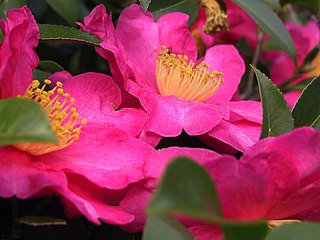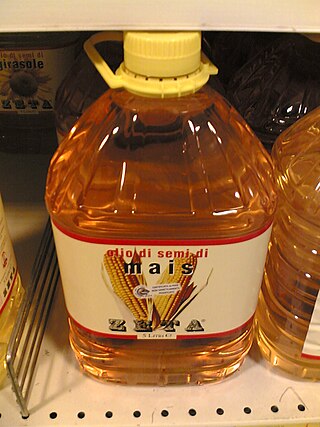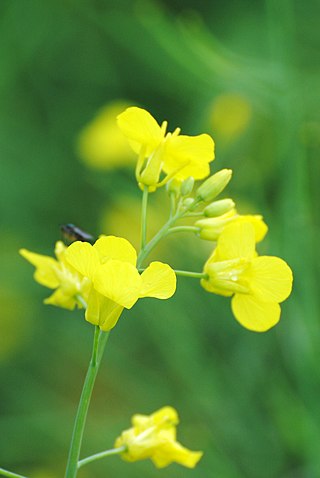
Tea seed oil (also known as camellia oil, camellia seed oil, teanut oil) is an edible plant oil. It is obtained from the seeds of Camellia oleifera .
Contents
Camellia sasanqua is also given as a source of 'tea seed oil. [1]

Tea seed oil (also known as camellia oil, camellia seed oil, teanut oil) is an edible plant oil. It is obtained from the seeds of Camellia oleifera .
Camellia sasanqua is also given as a source of 'tea seed oil. [1]
The genus Camellia includes several commercially important species - Camellia oleifera is grown mainly in China for vegetable oil. [2] The oil is known as 'camellia oil', 'tea seed oil', or 'camellia seed oil'. [2] As of 2016 4,000,000 hectares (9,900,000 acres) of oleifera forest centered on the Yangtze river basin in Hunan, Jiangxi, and Guangxi produces 0.26 million tons of oil. [2]
Wild Camellia oleifera contains ~47% oil, whilst cultivated varieties have shown oil content from 42 to 53%. [3] Oil analysis of cultivated varieties showed : ~76-82% oleic acid; 5-11% linoleic acid; 7.5-10% palmitic acid; 1.5-3% stearic acid - the ratios are similar to that found in wild oleifera. [3] The composition is similar to that of Olive oil. [2] Another analysis of several cultivars found : 82-84% unsaturated acids of which 68-77% oleic acid; and 7-14% polyunsaturated acids. [4]
With its high smoke point of 252 °C (486 °F), [5] tea seed oil is the main cooking oil in some of the southern provinces of People's Republic of China, such as Hunan, especially in mountainous regions; roughly one-seventh of the country's population.
The oil has also been used in Chinese traditional medicine - here[ further explanation needed ] it has been used as a dietary supplement for the digestive system, as well as to manage cholesterol, as well as strengthen the immune system. It was also used topically as baby lotion and for burn injuries. [2]
Tea seed oil should not be mistaken for tea tree oil (melaleuca oil), an inedible essential oil extracted from the leaves of the paperbark, Melaleuca alternifolia , which is used for medicinal purposes.

Camellia is a genus of flowering plants in the family Theaceae. They are found in tropical and subtropical areas in eastern and southern Asia, from the Himalayas east to Japan and Indonesia. There are more than 220 described species. Camellias are popular ornamental, tea and woody-oil plants that have been cultivated throughout the world for centuries. To date, over 26,000 cultivars, with more than 51,000 cultivar names including synonyms, have been registered or published.

α-Linolenic acid, also known as alpha-linolenic acid (ALA), is an n−3, or omega-3, essential fatty acid. ALA is found in many seeds and oils, including flaxseed, walnuts, chia, hemp, and many common vegetable oils.

Oleic acid is a fatty acid that occurs naturally in various animal and vegetable fats and oils. It is an odorless, colorless oil, although commercial samples may be yellowish. In chemical terms, oleic acid is classified as a monounsaturated omega-9 fatty acid, abbreviated with a lipid number of 18:1 cis-9, and a main product of Δ9-desaturase. It has the formula CH3−(CH2)7−CH=CH−(CH2)7−COOH. The name derives from the Latin word oleum, which means oil. It is the most common fatty acid in nature. The salts and esters of oleic acid are called oleates. It is a common component of oils, and thus occurs in many types of food, as well as in soap.

Safflower is a highly branched, herbaceous, thistle-like annual plant in the family Asteraceae. It is commercially cultivated for vegetable oil extracted from the seeds and was used by the early Spanish colonies along the Rio Grande as a substitute for saffron. Plants are 30 to 150 cm tall with globular flower heads having yellow, orange, or red flowers. Each branch will usually have from one to five flower heads containing 15 to 20 seeds per head. Safflower is native to arid environments having seasonal rain. It grows a deep taproot which enables it to thrive in such environments.

Camellia sinensis is a species of evergreen shrub or small tree in the flowering plant family Theaceae. Its leaves, leaf buds, and stems can be used to produce tea. Common names include tea plant, tea shrub, and tea tree.
In biochemistry and nutrition, a monounsaturated fat is a fat that contains a monounsaturated fatty acid (MUFA), a subclass of fatty acid characterized by having a double bond in the fatty acid chain with all of the remaining carbon atoms being single-bonded. By contrast, polyunsaturated fatty acids (PUFAs) have more than one double bond.

Pumpkin seed oil is a culinary oil, used especially in eastern Europe.

Corn oil or maize oil (British) is oil extracted from the germ of corn (maize). Its main use is in cooking, where its high smoke point makes refined corn oil a valuable frying oil. It is also a key ingredient in some margarines. Corn oil is generally less expensive than most other types of vegetable oils.
The smoke point, also referred to as the burning point, is the temperature at which an oil or fat begins to produce a continuous bluish smoke that becomes clearly visible, dependent upon specific and defined conditions. Smoke point values can vary greatly, depending on factors such as the volume of oil utilized, the size of the container, the presence of air currents, the type and source of light as well as the quality of the oil and its acidity content, otherwise known as free fatty acid (FFA) content. The more FFA an oil contains, the quicker it will break down and start smoking. The lower the value of FFA, the higher the smoke point. However, the FFA content typically represents less than 1% of the total oil and consequently renders smoke point a poor indicator of the capacity of a fat or oil to withstand heat.

Soybean oil is a vegetable oil extracted from the seeds of the soybean. It is one of the most widely consumed cooking oils and the second most consumed vegetable oil. As a drying oil, processed soybean oil is also used as a base for printing inks and oil paints.
Ramtil oil, also known as Niger seed oil, is used mainly in cooking but also for lighting. In India it is pressed from the seed of Guizotia oleifera of the family Asteraceae. A very similar oil is made in Africa from G. abyssinica. The oil is used as an extender for sesame oil, which it resembles, as well as for making soap, in addition to its role as an illuminant.

Sunflower oil is the non-volatile oil pressed from the seeds of the sunflower. Sunflower oil is commonly used in food as a frying oil, and in cosmetic formulations as an emollient.

Behenic acid is a carboxylic acid, the saturated fatty acid with formula C21H43COOH. In appearance, it consists of white solid although impure samples appear yellowish.

In biochemistry and nutrition, a polyunsaturated fat is a fat that contains a polyunsaturated fatty acid, which is a subclass of fatty acid characterized by a backbone with two or more carbon–carbon double bonds. Some polyunsaturated fatty acids are essentials. Polyunsaturated fatty acids are precursors to and are derived from polyunsaturated fats, which include drying oils.

Camellia oleifera, which originated in China, is notable as an important source of edible oil obtained from its seeds. It is commonly known as the oil-seed camellia or tea oil camellia, though to a lesser extent other species of camellia are used in oil production too.

Marula oil is extracted from the kernels (nuts) of the fruits of the Marula tree, from the family Anacardiaceae. There are two types of marula oil, the oil extracted from the seeds and the oil extracted from the nut's hard shell. Marula oil is traditionally used in cosmetics, in food as a cooking oil and meat preservative and to treat leather. Marula oil can also be used as body lotion. In Namibia Marula fruit is processed into a range of juices, jellies and jams.

Nervonic acid is a fatty acid. It is a monounsaturated analog of lignoceric acid (24:0). It is also known as selacholeic acid and cis-15-tetracosenoic acid. Its name derives from the Latin word nervus, meaning nerve or sinew.

Cooking oil is a plant or animal liquid fat used in frying, baking, and other types of cooking. Oil allows higher cooking temperatures than water, making cooking faster and more flavorful, while likewise distributing heat, reducing burning and uneven cooking. It sometimes imparts its own flavor. Cooking oil is also used in food preparation and flavoring not involving heat, such as salad dressings and bread dips.

Rapeseed oil is one of the oldest known vegetable oils. There are both edible and industrial forms produced from rapeseed, the seed of several cultivars of the plant family Brassicaceae. Historically, it was restricted as a food oil due to its content of erucic acid, which in laboratory studies was shown to be damaging to the cardiac muscle of laboratory animals in high quantities and which imparts a bitter taste, and glucosinolates, which made many parts of the plant less nutritious in animal feed. Rapeseed oil from standard cultivars can contain up to 54% erucic acid.